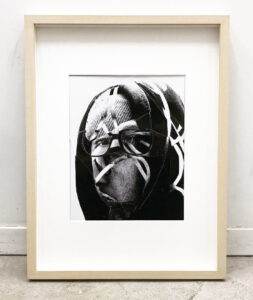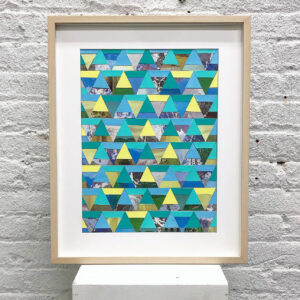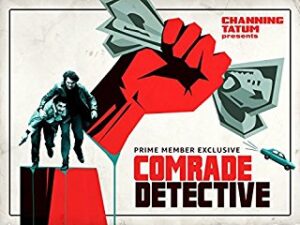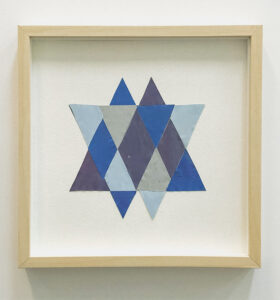This post is part of our series to inspire students to consider continuing their studies. See related posts at the bottom of the page.
 A practicing fine artist and promising librarian-archivist, Brian Michael Bell brought a brand new flavor to Books We Read, when he started to discuss photography books in his posts, contributing as an SA, that is a SC&I Assistant, a term used for Master’s of Information graduate students working for New Brunswick Libraries. In our interview series, we asked him about the motivations of the artist to get a regular job and his plans and expectations after graduation.
A practicing fine artist and promising librarian-archivist, Brian Michael Bell brought a brand new flavor to Books We Read, when he started to discuss photography books in his posts, contributing as an SA, that is a SC&I Assistant, a term used for Master’s of Information graduate students working for New Brunswick Libraries. In our interview series, we asked him about the motivations of the artist to get a regular job and his plans and expectations after graduation.
BWR: How long have you been working in libraries and archives?
BMB: My library career started when I moved to New York City in 2002. I worked at The New York Public Library for the Performing Arts from 2002 -2005, then transferred to The Miriam and Ira D. Wallach Division of Art, Prints and Photographs at NYPL where I worked until 2010. Recently I worked part-time at Alexander and Douglass Libraries for my final semester at Rutgers. So I have worked in libraries and special collections off and on for almost 9 years.
BWR: What inspired you to make it official and go back to school for your Master’s of Information?
BMB: The pandemic made me reevaluate my career as a graphic designer, which I was doing for the past ten years in New York City. The design industry is very demanding and fast-paced, and I was burned out from that lifestyle. At the beginning of the pandemic the design industry that I was working in (Music & Live Entertainment) more or less shut down, so I was out of work and nervous about what to do next. My family also moved to New Jersey during the end of the pandemic, so I decided to take a big risk and enroll into Rutgers Master’s of Information program. In a way I felt that working in libraries would be a more stable career path, and I also felt I was the happiest when working at NYPL.
BWR: Working at the reference desk in the Alexander and Douglass Libraries three days a week, you quickly became a familiar face on campus. How did you find the experience with students and other users?
BMB: Working at Alexander and Douglass Libraries was the best decision I made while being a Grad Student at Rutgers! I did all of my courses asynchronously, so I never stepped foot onto Rutgers campus until I took the Student Assistant position at Alexander and Douglass. That being said, the experience has been great, and I feel I learned a lot about reference services in such a short time. Online learning is very isolating, so having the opportunity to work with students and other users was exciting and built up my confidence in public speaking and communicating with the public.
BWR: You worked in two very different environments and got involved in special projects, including outreach and events programming. You had the opportunity to work with diverse users as well several as colleagues. How did the various assignments meet the expectations you had towards the profession?
BMB: I honestly didn’t know what to expect when taking the SA position at Alexander and Douglass Libraries. Every day was a new experience and I was learning a lot very quickly, which made it exciting for me. I enjoyed the more complex reference interviews that would challenge me, but spending time and talking with other staff members helped me see a future in working as a reference librarian.
BWR: You are an accomplished fine artist, mixing media and themes in your unique way from a fresh perspective. The result is artwork that “speaks” to the individual, as we say in our bibliotherapy-centered world at Books We Read: the reader, or in your case, the viewer has the chance to relate to the text or the artwork. Speaking of your “Selfies” photo collage series from 2019 first as an example, everyone can feel the seemingly unrelated or broken pieces that go into the presentation of the self in social media. Before you enrolled in the MI program, how did you think the library experience would help your work as an artist?
BMB: Well the “Selfies” photo collage series has a funny back story. When I lived in Brooklyn I had an art studio that did not have great heat in the winter. So I decided to take random “selfies” of myself feeling miserable and frustrated with the lack of heat in the mornings while I worked. I decided to collage the black & white printed photos and try to depict the opposite of what most people try to capture when doing “selfies”…..someone who is happy and trying to enhance their appearance for social media. In regards to how the library experience would help my work as an artist, I would say access to material within the collection would be the most helpful. I have always found library collections to be inspiring, there is so much visual stimuli in the stacks. A lot of my earlier work was collaging discarded material from public libraries, such as old catalog cards, acid stained folders, etc. I found this material beautiful, the aging process was unique and had so much character.
 BWR: Following up on your artwork, with their colorful representation of uppers and downers in such a talented way, “Drug Rugs” speak to specific audiences, that is, people with substance use disorders as well as their loved ones, and all those who worry about them. It’s amazing how you enlisted resources and tools at hand, such as spray paint, ink transfer, origami paper, newspaper, and playing cards. Art therapy is another licensed profession, however, the bibliotherapy-focused eyes can see intense and jumbled emotions in these works as well as the sub-text advocating for self-expression via creating and “reading” art. Or does this sound too far-fetched?
BWR: Following up on your artwork, with their colorful representation of uppers and downers in such a talented way, “Drug Rugs” speak to specific audiences, that is, people with substance use disorders as well as their loved ones, and all those who worry about them. It’s amazing how you enlisted resources and tools at hand, such as spray paint, ink transfer, origami paper, newspaper, and playing cards. Art therapy is another licensed profession, however, the bibliotherapy-focused eyes can see intense and jumbled emotions in these works as well as the sub-text advocating for self-expression via creating and “reading” art. Or does this sound too far-fetched?
BMB: I chose to call that series of collages “drug rugs” as a nod to the hippie culture who coined the term “drug rug” for the iconic baja hoodie that is widely worn by them. But the true concept of the “drug rugs” series was my fascination with islamic prayer rug patterns. The patterns can be complex and are truly breathtaking. But I also saw these woven patterns similar to 1960s counter-culture psychedelic art, which was loosely based on hallucinating effects of LSD drug trips. By combining the patterns of prayer rugs with my collaging techniques, I was able make a visually striking piece of art that seems organized. But when you look closely there is a lot of chaos and confusion in the medium. As you pointed out, you can see intense and jumbled emotions in my collages, this is deliberate and the goal has always been to show the viewer the imperfections in my work. Making collage art does not come easy to me, and I get frustrated with the process. So in a way, making art is therapeutic as I force myself to be patient with the medium.
 BWR: With the practice of using our one-minute designs for illustrations at Books We Read (the lack of our graphic design background is the lame excuse), we also admire your work as a graphic designer, a job where one isn’t often given a whole lot of credit for their work (book jackets, social media, and the like). When we watched the hilarious Comrade Detective, little did we know that you were also behind the brilliant poster and other digital media advertisements of this Amazon Prime title! A remnant of communist propaganda, the raised fist sets the tone for the movie, while with the dollars grabbed by the hand, it also mocks the hypocrisy of these dictatorships. And as for the geopolitical undertone, even the car, a Dacia, manufactured in Romania is right! This is where the researcher-designer comes to mind. Or are we reading too much into a movie poster? How does your passion as an archivist influence your work as an artist?
BWR: With the practice of using our one-minute designs for illustrations at Books We Read (the lack of our graphic design background is the lame excuse), we also admire your work as a graphic designer, a job where one isn’t often given a whole lot of credit for their work (book jackets, social media, and the like). When we watched the hilarious Comrade Detective, little did we know that you were also behind the brilliant poster and other digital media advertisements of this Amazon Prime title! A remnant of communist propaganda, the raised fist sets the tone for the movie, while with the dollars grabbed by the hand, it also mocks the hypocrisy of these dictatorships. And as for the geopolitical undertone, even the car, a Dacia, manufactured in Romania is right! This is where the researcher-designer comes to mind. Or are we reading too much into a movie poster? How does your passion as an archivist influence your work as an artist?
BMB: A major part of being a graphic designer is visual research and developing a group of assets for inspiration before beginning a project. Every designer does this differently, but I usually would dive deep into the Internet and look for imagery that could help enhance the story you are trying to tell. I also have a large personal archive of textures, unique fonts, and other ephemera that I would use regularly for my designs. I guess my passion as an archivist would definitely be reflected in the organization of my design files. I have a massive collection of material that I would reference daily when I worked at design agencies. The internet is an amazing source of information for graphic designers and there is alot of education, file sharing, and creativity to be found. I would hate to say this, but I didn’t go to college for graphic design, I self taught myself everything through YouTube and learning on the job!
BWR: I see, so it does go both ways! Now looking at your “52 weeks” series, one can only wonder what you’re working on now while at school. How did the Rutgers experience contribute to your overall professional development and what kind of impact, if any, did it have on you as an artist?
 BMB: The “52 weeks” series was a conceptual project in that I forced myself to make a collage every week, document it, and share it on social media for one year. At first this was an exciting and creative endeavor, but the process started to be challenging trying to juggle work, raising a child, etc. In the end, I was very proud of that series and I always wanted to show that work as a completed series in a gallery.
BMB: The “52 weeks” series was a conceptual project in that I forced myself to make a collage every week, document it, and share it on social media for one year. At first this was an exciting and creative endeavor, but the process started to be challenging trying to juggle work, raising a child, etc. In the end, I was very proud of that series and I always wanted to show that work as a completed series in a gallery.
In regards to how the Rutgers experience contributed to my overall professional development, prior to enrolling into the MI program I had very little experience with writing a research paper. This was a huge learning curve for me, and I struggled a lot the first semester. Over time I actually began to develop a strategy with my researching process, especially when searching specialized databases for scholarly articles. I also developed my personal style within my writing, and enjoyed the weekly discussions I would have with my fellow classmates and professors. As I graduate this semester, I feel I have transitioned into a scholar with a strong understanding of academia and libraries, and I am very eager to find employment in the field.
BWR: The Archives and Preservation track at SC&I provides courses for the degree requirements. However, we at Books We Read strongly believe graduate students must take control over their careers the moment they are admitted to the program and have provided opportunities to expand their knowledge and grow their CVs. What would you recommend to fellow students who wish to complement their studies with hands-on experience?
BMB: I would recommend to any graduate student to take full advantage of internships or part-time work that is available to them at Rutgers. There is only so much you can learn from the classroom, and I think anyone who is enrolled in the MI program should consider working part-time in reference services if possible. The experience of communicating and assisting the students at the reference desk is a skill that can really only be learned in person. Even though this may not be the career path you choose to do, I personally feel it is a necessary skill to learn before entering the job market.
BWR: Thank you for your time. It’s been a pleasure working with you! We at Books We Read wish you all the best with you careers, both as an archivist-librarian and an artist.
BMB: Thank you, I had such a great experience with Books We Read and appreciate the opportunity!
Additional reading about graduate programs, careers, and personal stories
- Becoming a Librarian, Step 1: The MLIS – Harmony Birch’s recap of her personal journey to become a librarian
- A Collector of Things from the Master of Information Program – Kate Greenberg tells her story leading her to archives
- End of Semester Wrap-up from the Archival Project Assistant by Kate Greenberg about her role in creating a Digital Library
Reflections on a PhD in Literature by Nicholas Allred, founding member of Books We Read, walks the reader through a reading-heavy graduate experience
More inspirational interviews
Becky Diamond about her passion as a food historian
- Books We Write: Historic Recipes and Stories from the Gilded Age
- Books We Write: Writing Food History
Art Librarian Megan Lotts on creativity in libraries that Books We Read adopted
Interviews with Authors: Images of America – South River by Stephanie Bartz
Interviews with Authors: A Bibliotherapy Reader in Hungarian by Judit H. Ward